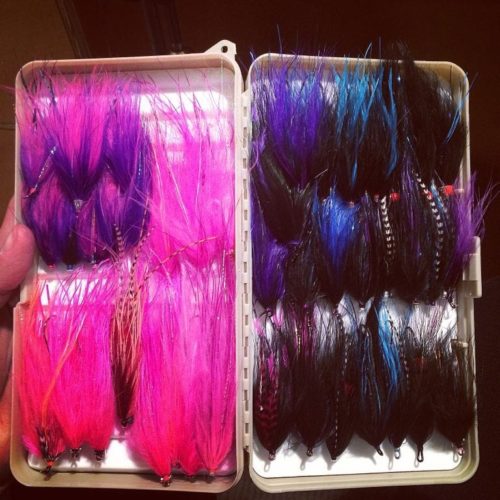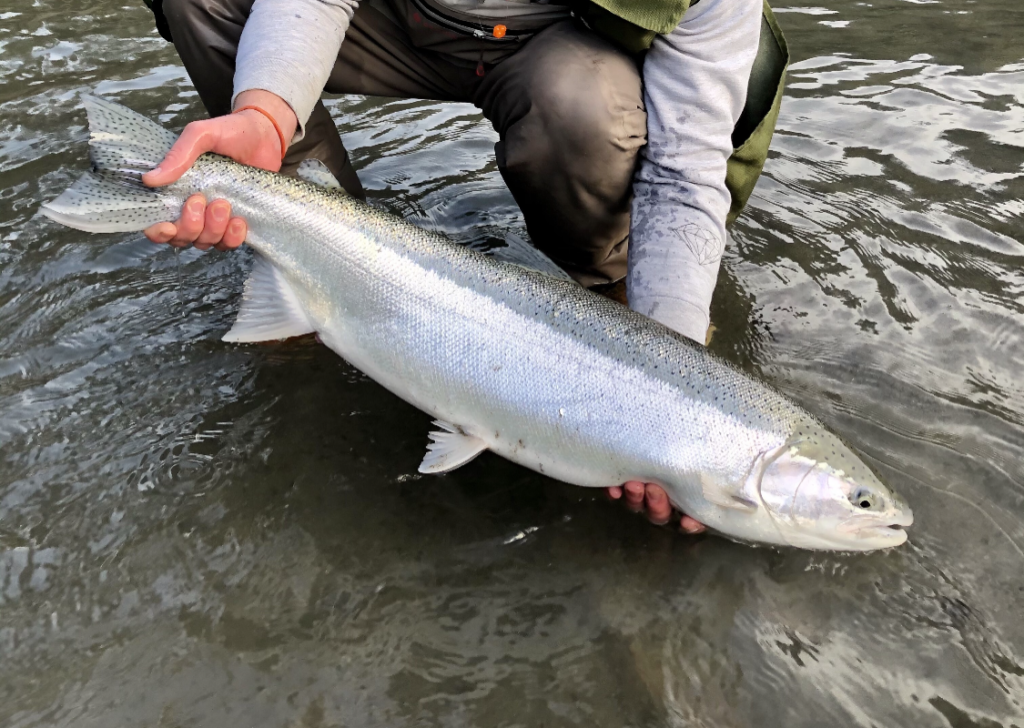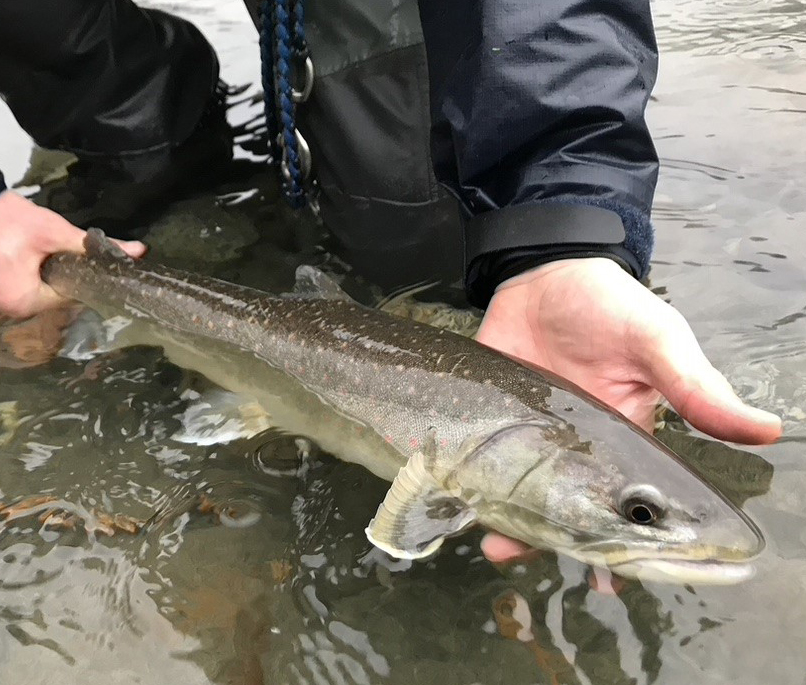OUTLOOK
It has been a wet week but there were windows of good fishing. We have 3 major fisheries to look at this week. One is doing relatively well; one is pulling through with “average” reports but we expect better things to come, and another is raising some eyebrows with concerning numbers.
The bright spot this week is the valley steelhead reports. Even though river levels have been a challenge the week and the fishery in general is never a gangbuster affair, the reports when the water levels have been “in” have been good. We have a great Steelheading Technique review where Alex goes over some of the mindsets needed to be a successful steelheader and Taylor has an update on the fishing.
The fishery that has been trucking along and putting up average reports has been the winter chinook fishing. It has been nothing to write home about but most experienced anglers are finding fish in local waters plus the crabbing and prawning has been good. Jason has details in the saltwater section.
The egg eater fishery up Sea to Sky is the one that hasn’t been pumping out great reports. We have heard of a few successful trips and Matt is out this week so we should have more intel next week but things have been notably slower than normal. We have details in the river section below and Matt goes over the weather in the video version of the report.
We are also still running our “Best of 2020” fishing picture contest. Though it was a challenging year for everyone, we want to see everyone’s best 2020 fish pictures. Something we can all look back on with a smile. We have seen a ton of great photos already but there is still time to send in your best as the deadline is not until January 27, 2021. The winner will be announced on the 29th and get a $100 gift card to the store. Matt has all the details in the video version of the report. Email your pictures to info@pacificangler.ca and check out the video version of this week’s report here!
CLASSES AND COURSES
We were back in the zoom classroom this week and it sure feels good to be starting our 2021 courses and getting to see you all over zoom or in person as COVID guidelines allow. If you haven’t checked out our classes be sure to do so. The full list can be found here and if the course you had an eye on is full don’t hesitate to add yourself to the waitlist as we often add more dates.
Next week we’ve got one spot available for our “Tying Essential Steelhead Patterns Course”. This course is designed for the fly tyer looking to get the best start on tying steelhead patterns. In the 3-hour evening seminar your instructor will cover everything from tying techniques, materials, colour choices, size and weight. They will walk you through 3 essential patterns that will build a well-rounded steelhead fly box. If you’re looking to get yourself into tying your own flies for steelhead, this is the course for you. This course is suitable for fly tiers with a basic knowledge. Students are required to supply their own vise, tools and materials. A 10% discount is available on materials and tools purchased for the course.
Cost: $50.00
Dates: Jan 20, 2021
Time: 6:30pm – 9:30pm
Note: this is an in-person course with reduced # of students and distancing measures in place. Masks are required to be worn the duration of the course.

FRESHWATER FISHING REPORTS
Steelhead Technique Review
With the rivers being so blown out this week I know a bunch of you, myself included, are itching to get back out on the water once things settle down a bit. I’ve been tinkering with my gear a bit and making sure everything is in tip top shape; I even got a test run out on the water this past week before the rain and got to iron out some old bad habits of mine and shake off the rust. Now keeping your gear in working order is important; this includes retying your leader boards, replacing old hooks on your spoons/spinners, re-greasing/oiling your reels, and so on. However, the other part that is crucial to Steelheading is remembering how it differs from Salmon fishing. It’s easy to get complacent and fall back into the trappings of those habits some of us develop over the Fall, but an integral piece in successfully getting into a Steelhead is how you approach the water.

Before we even begin to think about the baits, lures, or flies that you want to throw at the Silver Ghosts, the first thing that you want to always keep at the forefront of your mind is covering water. Being able to cover a lot of ground efficiently is key as a lot of the time it doesn’t necessarily matter what you throw at a Steelhead, but it does matter that you get your presentation to that fish. Now this isn’t to say that you should blast through every single run on the river at light-speed. Knowing where and when to speed up or to slow down is important and as long as you keep on moving this will continuously keep you on the high percentage spots over a greater amount of time.
Now the speed that you approach a run will depend on the holding power of that run. Is it a pool with a tasty tail-out just above some rapids? Or are you firing through a bunch of pockets that the fish are going to have a fleeting rest in before moving through? Taking the first scenario of a long classic run with a tail-out, I like to take a 5-step approach. Starting at the top, cover the water in front of you from inside out, doing enough casts to get one or two drifts through each line and going further out with each subsequent cast. Once you’ve reached your casting limit or exhausted the holding water in front of you, take five giant steps downstream and then repeat.
What about pocket water then? Make no mistake, pockets can have significant holding power and some of your most exciting battles will be in fast rapids. In saying that, this is a scenario where you want to work as quickly, though still efficiently, as possible. Due to the nature of the holding areas, typically behind a rock or some other sort of structure, most fish will only get a good look at your presentation for a few seconds and will either strike it or it won’t. In addition, these resting spots are not considered prime holding water and, as such, fish tend to shoot through these sections fairly quickly. Don’t disregard pockets when you see them, but don’t spend 10 minutes at one regardless of how tasty it looks. Put in a couple of good casts to the seams and then keep moving.
Now let me backtrack when I said that it doesn’t really matter what you throw at a Steelhead. It does, but my intent was to illustrate how pertinent reading water is to this fishery. It is true that a typical Steelhead is quite aggressive especially when compared to Salmon. I have seen them go out of their way, even crossing entire runs, to smash something on the opposite side of the river. This holds for most Steelhead, but what we haven’t factored in is the amount of angling pressure that gets put on these fish. Our big Steelhead fisheries are heavily utilized, making these particular populations a little more “irregular”. The aggressive fish get weeded out pretty quick or get hooked a few times and wise up, leaving us with a bunch of tight-lipped Steelhead. Sounds like Salmon season all over again!
One common way to get around this is to get more finesse and downsize your presentations. This can work wonders, but what happens if the conditions you are in don’t allow for downsizing or there is just a ton of angling pressure on a run before you got to it? One of the biggest game changers, in my opinion, is to be different. Being different means just that; use something different! If your buddy goes through some water before you and shakes it up with roe, don’t be the second, third, or fourth guy to use roe as well. This is especially true on big hatchery-enhanced fisheries like the Vedder. If you are fishing good water, you are probably fishing over a bunch of fish. With this in mind, there is no reason to run the same presentation everyone else in front of you is running especially if they aren’t getting any responses to it. I can’t tell you how many times where one person has been flogging a piece of water for half an hour and coming up empty handed, only to have another angler step in, with a different presentation, and bury the hook set on a Steelhead on their first cast.
The last thing I will touch on is water conditions and preparing for them. I won’t elaborate too much as this part is fairly self-explanatory, but making sure you are bringing the right gear for the job is crucial. If the water is high, bring your big presentations, heavy gear, and be prepared to hike lots of kilometers to find that soft water the fish will be pushed into. If the water is low, then time to pull out your fluorocarbon and smaller/lighter gear. Read the water and figure out where fish will be depending on the conditions you are fishing and eventually things will fall into place.
If you need any more pointers or want to get set up for this Steelheading this winter, come visit us at the shop!
Alex Au-Yeung
Vedder/Chilliwack River Fishing Report
It’s been another moist week, but in the relatively brief periods where the Vedder/Chilliwack has been fishable, it’s been producing decent numbers of fish. It’s still recovering from the mid-week blowout as of Thursday, but it should be in decent shape for the weekend again.
I wouldn’t be surprised if the heavy rains changed the river again, but they also should’ve pushed some fresh fish into the system. Likewise, the higher water levels will have given fish the opportunity to move throughout the system, so there should be fish from top to bottom. Last weekend was pretty good, so let’s hope this weekend fishes well.
The gear you fish will depend on what the water will be doing when you head out. It’s not supposed to rain much, but I’d still bring some small gear and some bigger stuff… don’t wanna get caught out with the wrong gear for the conditions at hand.
Remember to cover water and be considerate to other anglers… we all want to get into some fish, not a yelling match.
Taylor Nakatani
Squamish River Fishing Report
This past week saw some tough conditions and weary fish, with a few anglers being rewarded for their persistence. At this time of year, both fly and gear anglers usually do more scouting than fishing, with the early work sometimes paying off later in February thru April.
Tactics and gear haven’t changed much since last week. We are getting mixed reports from the egg eater fishery. It has been “ok” at best and many days have been a challenge. It is something to note and consider. Historically, we would only be fishing artificial salmon egg presentations this time of year but many anglers have been splitting their time 50/50 between swung fly or spinner style presentations. We won’t jump to any conclusions from this observation but it does raise some conservation questions.

We still encourage everyone to get out, cover ground, enjoy the good exercise and the vital connection we all feel when spending time on the water but also treat all caught fish with the utmost case and respect habitat where salmon were spawning last season and we look forward to the early spring season. Matt is out this week and will have more intel in next week’s report.
Keep trekking,
Jordan Simpson
SALTWATER FISHING REPORTS
Vancouver Saltwater Salmon Fishing Report
Due to Covid restrictions and the nasty winds and rain, we haven’t been out on the water much these past few weeks. Some of our colleagues and customers did make it out on the few calm days and the reports were fairly standard for this time of year. Put in the time and get a few fish.
Unfortunately, the number of fish being lost to seals in most of the popular spots in Howe Sound and in Vancouver Harbour is at a new level. Without a doubt, there are more seals and more educated seals, ones that follow you and wait for you to hook a fish. This is becoming a major concern and is having a significant impact on people’s ability to fish for and harvest winter chinook in the Vancouver area. I am not sure what we can do about it. Basically, short of a permit for removal of these particular animals, they are here to stay. It’s not likely that is going to happen unless First Nations is granted permits for harvest, and there is some effort towards this, but it is years away at best in my honest opinion. So, for now, the best thing you can do if a seal is following you is to pick up and move.
We have been getting some really good reports from the South Vancouver Island, so that is promising. There are good numbers of legal fish, with most of them being adipose clipped, hatchery fish, mostly from the USA. Some of those fish will make it up to our waters in the coming weeks, so that is good news indeed. If conditions allow, now would be a good time to make a run across to the Gulf Islands as they usually produce well in January for winter chinook.
Prawning continues to be consistent. Remember to carefully release all berried females.
See you in the shop or on the water,
Jason Tonelli




